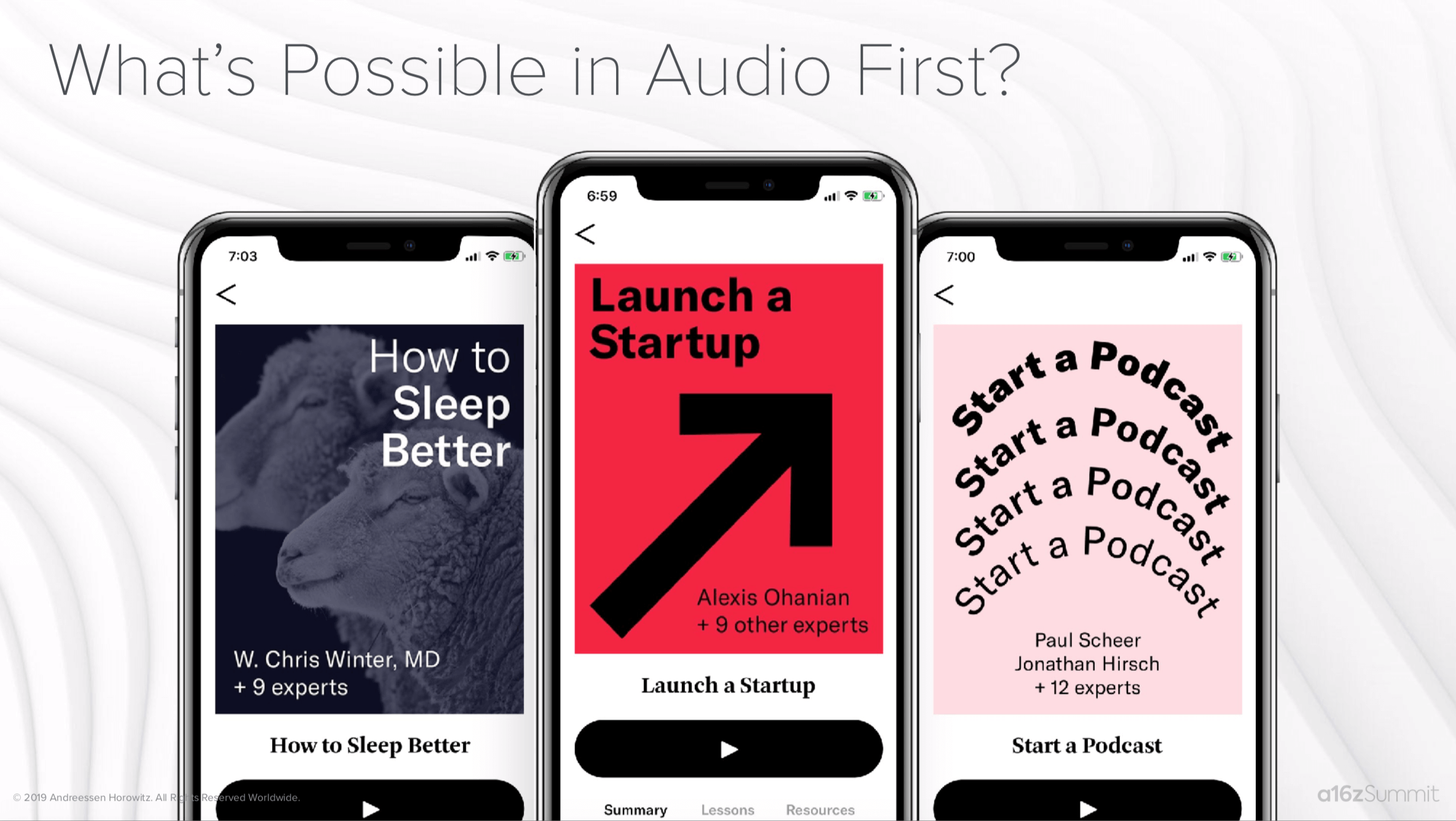This is a written version of a presentation I gave live at the a16z Summit in November 2019. You can watch a video version on YouTube.
With so much technology in our everyday lives, it’s easy to wonder: Are we at the end of innovation for consumer tech? I believe we’re still at the beginning—there’s a lot more change to come. In particular, I’m really excited about four trends:
Everything will become a super app
Companies will work together to offer customers more unique products and services, discovering new revenue streams in the process.
Everything will become commerce
In the near future, we will be all shopping from our entertainment apps, including video, social media apps, and messaging.
Increasingly, tech will go physical
Our digital identities will be linked with our physical ones.
Earshare is the new mindshare
Companies will take advantage of the massive explosion in audio consumption and podcasts.
Everything will become a super app
According to eMarketer, in 2019 we spent more time on our cell phones than watching television: 3 hours and 43 minutes, on average, compared to 3 hours and 35 minutes.
The problem is that the average person is spending nearly than three hours of that time on apps. Only the small remainder—26 minutes—is being spent in the mobile browser. So, the long tail of the internet is not migrating over to the phone.
The other problem is that people are not downloading as many apps. In fact, the average person will download zero apps every month. What does that mean for all of us? How do we fix the problem? The answer is super apps.
This is the home tab of Meituan, a popular food delivery service in China. In 2013, Meituan started thinking about what other revenue streams it could create—they added a button on top where you could start booking hotel nights. Today, Meituan is responsible for booking nearly 50 percent of hotel stays in China. The previous big player, Ctrip, is down to 22 percent.
You can also find attractions, nightlife, movie tickets, bike-sharing and much more on Meituan. The company took a high-frequency, low-margin business—food delivery—and tacked on more low-frequency, high-margin businesses at low (or zero) customer acquisition costs. Meituan is leveraging its distribution and understanding of its customers, thinking what other revenue streams can I create with that mindshare?
Meituan is just one of many examples. In China, they also have WeChat and Alipay. In Southeast Asia, there’s Gojek, which is used not only for transportation and food delivery, but also to book massage appointments, find moving services, and more. You can even use it to top up your mobile payment plan. And in the US, Uber is transforming itself from a transportation company into the operating system for our everyday lives. You see, super apps are here to stay, and the big internet giants in the States already get it. This trend is coming from East to West.
If you are lucky enough to be one of those high-frequency-use apps, what are new revenue streams that you can introduce to your customer? And if you’re not, what are other big, existing apps that you can partner with? What do you uniquely know about your customer that can add extra value to one of those big players?
Here’s one example of how you can discover your hidden data asset. Spotify, a music streaming service, knows a lot about my musical interests. They know which artists and podcasts I like. What else can this data be used for? Spotify could use that data to help artists and concert promoters figure out which cities they should be touring in. They should use data to inform their strategy. (“Should I spend one more night in New York or book that day at STAPLES Center?”) In fact, Spotify should be able to work with artists and tell them how to personalize their playlist for every single city. These are new revenue streams that Spotify can unlock by discovering their hidden data assets.
Who thought a music streaming app could have such a huge impact on concerts and live promotions? Similarly, who thought a short video app could empower all kinds of commerce?
Everything will become commerce
The second big trend is that everything is going to become transaction-related. We spend a lot of time in apps: video apps, communication apps, social media apps, and more. These apps are actually perfect distribution vehicles for commercials that we actually want to watch. Let me show you what that means, via live streaming apps and short video apps in China. On the left, you’ll see a farmer take you to his orange orchard and slice the fruit in front of your eyes. I think it’s the best commercial for fruit that I’ve ever seen.
Imagine yourself lying in bed at midnight, scrolling through a feed of videos, and seeing something like this. Your mouth starts watering. You would love to buy a box of those oranges. Well, the platform lets you do that. With a few taps of the screen, the user can get a box of those delicious oranges shipped right to their door. If you’re wondering how short video apps are going to monetize in the States, this is a one model. This is already happening in other countries.
On the right, here’s another example. This fisherman is catching a lobster that you can order online. When you click through the video, you can even find recipes on how to cook the seafood. In the US, we have a vague concept about what the phrase “farm to table” means. This is what farm to table really looks like; this is authenticity in context.
Tech goes physical
The third big trend I wanted to talk about is how technology is going to show up more and more in our physical world. In China, you already see more than 200 airports testing these kiosks. With facial recognition, they tell you exactly what gate to go to, and how to get there.
Classrooms are also leveraging facial technology to take attendance. You can no longer get away with asking your classmates to sign in for you.
Now, some of these may seem a little spooky. It’s enough to make you wonder: Will facial recognition ever be a big thing in the US? It’s already happening. Delta Airlines is actually testing facial recognition in some international airports for check-in and boarding. And 72 percent of people who use it prefer it to previous standard methods.
Some private schools in New York are using facial recognition to screen for guns and people who shouldn’t be on campus. Whether we like it or not, facial recognition is already being experimented with.
Here’s another example of technology showing up in our physical world. A UK-based company signed a two-year exclusive with Tencent to overlay all kinds of advertisements and pre-recorded video into movies and TV shows. Can you imagine watching your favorite movie from the ’70s or ’80s showcasing brands that you shop from today? This technology is already live and being used commercially.
Earshare is the new mindshare
And lastly, one of my favorite trends: we are listening to more podcasts than ever before. Audio consumption is exploding. That’s being driven by more than just the smartphone. It’s also hardware, better creation tools, and found time.
We now have wireless earbuds that allow us to listen to podcasts on the go. We have connected cars. We have smart speakers at home. New creation tools mean that anyone can record and edit their own podcast series from their bedroom.
Not to mention the glorious, magical experience of realizing that you have found time. I can listen to a podcast when I’m cooking breakfast, when I’m nursing my kid, or when I’m driving. I can now use all those moments that used to be somewhat mindless to embrace and consume audio content.
In fact, if you think about it, audio is a marketer’s dream. You are literally in their heads; they are a captive audience. Studies have already shown audio to be a very effective low-cost customer acquisition strategy.
So what does this consumption of audio and podcasts mean for us? A decade ago, we started thinking, “What does mobile-first product look like?” We started leveraging the camera and the GPS, and that brought us great companies like Instagram or Lyft. We now need to start thinking, “What does audio-first content look like?”
Allows you to introduce all kinds of magical moments, whether they’re sound effects or different narrative voices. This is a seed company that we invested in this year called Knowable:
They offer premium, curated audio courses on a variety of topics that people would pay money for, such as how to launch a startup, how to start a podcast, how to speak confidently, how to sleep better, and how to buy your first home.
And since they’re audio-first, of course they have sound effects, and of course they’re narrated by different voices. But these courses go a step further. They combine audio-first thinking with super-app thinking. If you bought the class titled “How to Launch a Startup,” you’re probably pretty serious about starting a business. So, they’re already working with AWS so that anyone who buys this course gets $1,000 in free credits for AWS.
Think about all the other kinds of partner and membership benefits that might be offered for topics like “How to Sleep Better” or “How to Buy your First Home.” That’s audio-first thinking combined with super-app thinking—it is powerful.
This is why I’m so excited about the future of consumer tech. Companies are starting to realize that they can leverage their distribution to create new revenue streams with more business partners. More commerce will start showing up in our video apps, social media apps, and messaging apps. We’re going to be shopping seamlessly, and commercials are going to become even better. We’re going to start thinking about an audio-first world. We’re going to see more tech and software permeate our physical worlds. And we’re all going to start figuring out that we need to work together to become super apps.
Let me give you one last analogy to crystallize what this thinking means. Imagine that you are getting married. You don’t have a wedding planner, so you go to a wedding venue to book it. That wedding venue probably has a recommendation for a florist, a photographer, a caterer, and a wedding planner. That’s because the offline world always understood how to think in a customer-centric way, as opposed to a product-centric way.
We need to adopt that same thinking—Who is your customer and what other services might they need that might not even be related to your core-service? We need to start uncovering our hidden data assets and brainstorming new revenue streams. And we need to start working together to unlock this great opportunity before us.











